Related Research Articles

The National Trust for Scotland is a Scottish conservation organisation. It is the largest membership organisation in Scotland and describes itself as "the conservation charity that protects and promotes Scotland's natural and cultural heritage for present and future generations to enjoy".

The Battle of Langside was fought on 13 May 1568 between forces loyal to Mary, Queen of Scots, and forces acting in the name of her infant son James VI. Mary’s short period of personal rule ended in 1567 in recrimination, intrigue, and disaster when, after her capture at Carberry Hill, she was forced to abdicate in favour of James VI. Mary was imprisoned in Lochleven Castle, while her Protestant half-brother, James Stewart, Earl of Moray, was appointed Regent on behalf of his nephew. In early May 1568 Mary escaped, heading west to the country of the Hamiltons, high among her remaining supporters, and the safety of Dumbarton Castle with the determination to restore her rights as queen. Mary was defeated and went into exile and captivity in England. The battle is generally considered the start of the Marian civil war.

Pollok is a large housing estate on the south-western side of the city of Glasgow, Scotland. The estate was built either side of World War II to house families from the overcrowded inner city. Housing 30,000 at its peak, its population has since declined due to the replacement of substandard housing with lower-density accommodation. As of 2021, the population was recorded at 81,951 people.
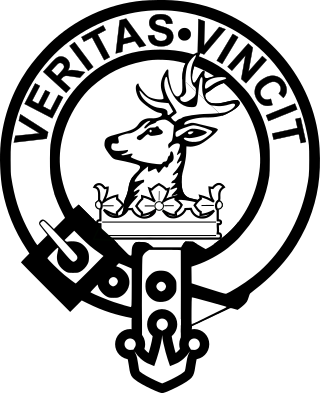
Clan Keith is a Highland and Lowland Scottish clan, whose Chief historically held the hereditary title of Marischal, then Great Marischal, then Earl Marischal of Scotland.
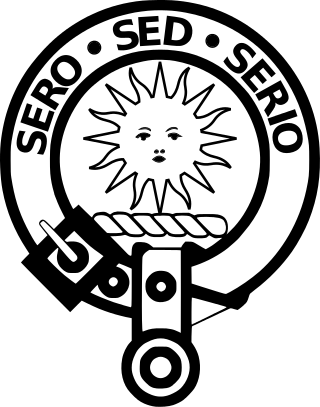
Clan Kerr is a Scottish clan whose origins lie in the Scottish Borders. During the Middle Ages, it was one of the prominent border reiver clans along the present-day Anglo-Scottish border and played an important role in the history of the Border country of Scotland.
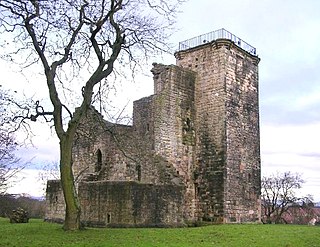
Crookston Castle is a ruined medieval castle in the Pollok area of Glasgow, Scotland. It is located some five miles southwest of the city centre, on a hill overlooking the Levern Water, just before its confluence with the White Cart Water. Crookston Castle was built by the Stewarts of Darnley around 1400, and is set within earthworks constructed in the 12th century. Once the property of the earls and dukes of Lennox, the castle was extensively repaired following a siege in 1544, and it is the only surviving medieval castle in Glasgow.
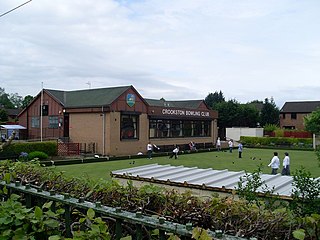
Crookston is a residential suburb on the southwestern edge of the city of Glasgow, Scotland.

Clan Barclay is a Scottish clan of the Scottish Lowlands.

Clan Borthwick is a Scottish clan.

Clan Menzies ; Scottish Gaelic: Clann Mèinnear; a member is a Mèinnearach) is a Highland Scottish clan.

Clan Boyle is a Scottish clan of the Scottish Lowlands.

Clan Stewart is a Scottish Highland and Lowland clan. The clan is recognised by Court of the Lord Lyon; however, it does not have a clan chief recognised by the Lord Lyon King of Arms. Because the clan has no chief it can be considered an armigerous clan; however, the Earls of Galloway are now considered to be the principal branch of this clan, and the crest and motto of The Earls of Galloway's arms are used in the Clan Stewart crest badge. The Court of the Lord Lyon recognises two other Stewart/Stuart clans, Clan Stuart of Bute and Clan Stewart of Appin. Stuart of Bute is the only one of the three clans at present which has a recognised chief.
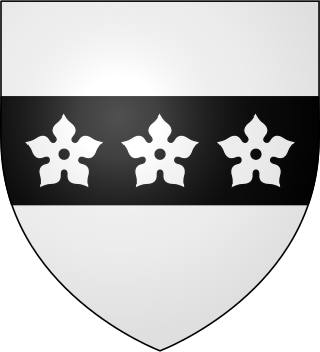
Clan Boswell is a Lowland Scottish clan and is recognized as such by the Lord Lyon King of Arms. However the clan does not currently have a chief and is therefore considered an Armigerous clan.

Clan Crawford is a Scottish clan of the Scottish Lowlands. The clan is of Scandinavian and Anglo-Saxon origin. There was in the early 18th century a mistaken belief that the clan had Norman origins. While historically recognised as a clan by the Court of the Lord Lyon, it is now an armigerous clan as it no longer has a chief. The last chief was Hugh Ronald George Craufurd, who sold his land and moved to Canada in 1904. He died in Calgary in 1942, leaving no male heirs.
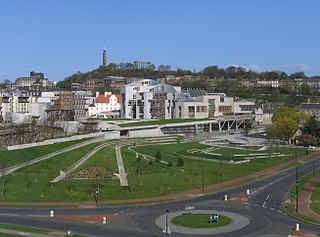
The architecture of Scotland includes all human building within the modern borders of Scotland, from the Neolithic era to the present day. The earliest surviving houses go back around 9500 years, and the first villages 6000 years: Skara Brae on the Mainland of Orkney being the earliest preserved example in Europe. Crannogs, roundhouses, each built on an artificial island, date from the Bronze Age and stone buildings called Atlantic roundhouses and larger earthwork hill forts from the Iron Age. The arrival of the Romans from about 71 AD led to the creation of forts like that at Trimontium, and a continuous fortification between the Firth of Forth and the Firth of Clyde known as the Antonine Wall, built in the second century AD. Beyond Roman influence, there is evidence of wheelhouses and underground souterrains. After the departure of the Romans there were a series of nucleated hill forts, often utilising major geographical features, as at Dunadd and Dunbarton.

Clan Munro is a Highland Scottish clan. Historically the clan was based in Easter Ross in the Scottish Highlands. Traditional origins of the clan give its founder as Donald Munro who came from the north of Ireland and settled in Scotland in the eleventh century, though its true founder may have lived much later. It is also a strong tradition that the Munro chiefs supported Robert the Bruce during the Wars of Scottish Independence. The first proven clan chief on record however is Robert de Munro who died in 1369; his father is mentioned but not named in a number of charters. The clan chiefs originally held land principally at Findon on the Black Isle but exchanged it in 1350 for Estirfowlys. Robert's son Hugh who died in 1425 was the first of the family to be styled "of Foulis", despite which clan genealogies describe him as 9th baron.

The Corbet family is an aristocratic English family of Anglo-Norman extraction, who were amongst the early marcher lords, holding the barony of Caus. Following the extinction of the senior line the junior line based at Moreton Corbet Castle would go on to become one of the most powerful and richest of the landed gentry in Shropshire. The family trace their ancestry to two barons found in the 1086 Domesday Book and they probably came from the Boitron and Essay region, near Sées in Normandy.
Cardonald Place Farm is a farmhouse on the banks of the White Cart Water river in Cardonald, Glasgow, Scotland. It was built in 1848 on the site occupied by the former Cardonald Palace.
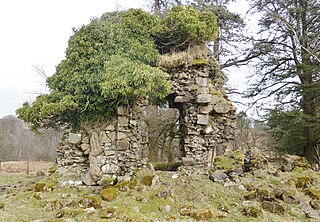
Cowden Hall, Cowdon Hall or Cowdenhall is an example of a laird's hall-house with a farmstead dating from more peaceful times in the seventeenth century when gun loops, thick defensive walls and well defended entrances were no longer essential and larger windows could be utilised. Eighteenth century additions included an outshot with a cruck roof. Cowden is located in an elevated position overlooking the Neilston Gap and the Levern Water on the lands of the old Barony of Cowden near Neilston in East Renfrewshire, Scotland.

Rosshall is an area in the south-west of Glasgow, Scotland, within the Cardonald ward of Glasgow City Council. It has a fairly isolated location, with the White Cart Water forming a border to the south and east, the Paisley Canal Line railway to the north, and open fields to the west that form a short green belt between Glasgow and the large town of Paisley – the nearest building 500 yards (460 m) to the west, Rosshall Mains Farm, falls under Paisley administration rather than Glasgow.
References
- 1 2 3 Barrow, G.W.S. (2003). The Kingdom of the Scots: Government, Church and Society from the Eleventh to the Fourteenth Century. Edinburgh University Press. ISBN 978-0-7486-1803-3.
- ↑ NMRS Site Reference NS56SW 4
- ↑ McDonald, Hugh (1910). Rambles Round Glasgow. John Smith & Son. p. 197. ASIN B0000EEFKR.